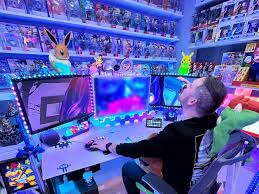The Villain’s Perspective: Exploring the Psychology of the Antagonist in Video Games
In the world of video games, players are typically conditioned to take on the role of the hero—the protagonist, who embarks on a journey to defeat evil, save the world, or conquer some monumental challenge. The villain, on the other hand, stands as the ultimate obstacle, an embodiment of darkness, chaos, or malevolence. But what if we shift the lens and examine the villain’s perspective? What if we step into the shoes of the antagonist and try to understand their motivations, struggles, and internal conflicts?
By exploring the mind of a video game villain, we can unlock a deeper layer of storytelling that not only enhances the emotional experience but also challenges our perceptions of good and evil. In this exploration, we will take a look at what it means to be a villain in video games, the complexities of their characters, and how seeing the world from their eyes might offer a more nuanced, and often more tragic, interpretation of their actions.
The Roots of Villainy: Trauma, Desperation, and Betrayal
At the heart of many great video game villains is a backstory full of tragedy, betrayal, and loss. These villains are not born inherently evil, but are shaped by their experiences and environment. Take, for example, The Joker from Batman: Arkham Asylum or Sephiroth from Final Fantasy VII. Both are iconic villains with rich, complex backstories that reveal how personal pain and loss can lead to destructive actions.
The Joker, a product of a broken and abusive environment, is a symbol of chaos who sees the world through the lens of anarchy, in part because of the atrocities he endured in his own life. His twisted sense of humor and love for chaos stem from his perception of a world that is inherently flawed. Similarly, Sephiroth, one of the most memorable villains in Final Fantasy VII, is a soldier who was manipulated by those he trusted and betrayed by the very people who created him. His descent into madness after discovering the truth of his origins provides a layer of tragedy that humanizes his violent ambitions.
From the villain’s perspective, these traumatic events are not just excuses—they are the formative experiences that shape their worldview. For them, their actions may feel justified or even righteous. They do not view themselves as inherently evil, but rather as individuals who have been wronged and are seeking to right what they perceive as an imbalance in the world.
The Villain as a Mirror to the Hero
One of the most compelling aspects of a well-written villain is how they often act as a mirror to the hero. In many cases, the villain and the hero are not opposites, but two sides of the same coin. They share common motivations or desires, but their methods and ideologies diverge, often leading them into conflict. For instance, in The Legend of Zelda: Ocarina of Time, Ganondorf and Link both seek power—Link to protect Hyrule and Ganondorf to control it—but their goals and means of achieving them could not be more different. While Link is driven by a sense of duty and the protection of his people, Ganondorf is driven by a thirst for dominance, believing that he is the rightful ruler of Hyrule.
From Ganondorf’s perspective, his actions are not born of wanton evil. He believes in his vision of a stronger, more prosperous kingdom under his rule. He sees himself as a leader capable of bringing order to a fractured land. His methods may be extreme, but they are rooted in his belief that he is the only one who can bring Hyrule to greatness. This is the complex duality that makes the villain’s perspective so interesting: what appears as evil from one side may appear as necessary and even righteous from the villain’s view.
A more extreme case might be Kefka Palazzo from Final Fantasy VI, who, unlike many villains, embraces pure chaos and destruction. Kefka, who once sought power in a more traditional sense, is driven by a desire to break the system entirely. For him, the destruction of the world isn’t about revenge or domination—it’s about eradicating the concept of order altogether. In Kefka’s eyes, the world’s structured chaos is a lie, and the only true freedom comes from dismantling it completely. His philosophy is a radical rejection of the status quo, one that challenges the hero’s conventional goals of order, peace, and stability.
The Tragic Villain: A Journey to Redemption?
Not all villains are pure embodiments of evil, and some may even evolve into sympathetic characters through the progression of the game. Consider Magus from Chrono Trigger, a character who begins as one of the main antagonists but reveals layers of complexity as his backstory is uncovered. Magus seeks to bring about the apocalypse to avenge the destruction of his sister, Schala, and is driven by deep sorrow and a thirst for revenge. However, by the end of the game, it is clear that his motivations are not born of a desire for mindless destruction, but of pain and loss. In many ways, Magus’s actions could be seen as a tragic cry for help—a way to regain something he has lost, even if it means damning the world in the process.
The possibility of redemption or understanding is a key aspect of many villains in video games. Vaas Montenegro from Far Cry 3 is an example of a villain whose personality and philosophical musings blur the line between sanity and madness. Vaas’s obsession with the nature of insanity and chaos offers an insightful commentary on the human condition. While his methods are violent and ruthless, his character complexity makes players question: could he have been different if life had dealt him a better hand?
Many players can relate to the idea of feeling misunderstood or misrepresented, and these villains often serve as exaggerated versions of those struggles. They provide a voice to those who, for whatever reason, feel pushed to the fringes of society. This gives them a kind of relatability, making it easier to empathize with them despite their destructive behavior.
Villains and the Concept of Power
At the core of many villainous characters is the pursuit of power—whether it’s power over others, power over a world, or the ability to shape their own fate. This pursuit is often framed as the villain’s ultimate flaw. However, this desire for power can be seen in a more empathetic light when we consider the struggles that drive it.
In games like The Witcher 3: Wild Hunt, the villainous figure of Eredin, leader of the Wild Hunt, is a tragic character motivated by the desire to restore his world and people, even if his methods are destructive. Eredin’s desperation to save his dying world mirrors the plight of many characters seeking to hold onto power, whether to protect their loved ones, control their environment, or assert their dominance over forces that threaten them. This common human desire to survive and control one’s fate is something that players can often understand, making the villain’s perspective both fascinating and complex.
The Villain as the Hero of Their Own Story
Ultimately, the villain in video games often serves as the hero of their own story. In their eyes, their actions are justified by their motivations, their desires, and their experiences. The hero, then, becomes the antagonist in the villain’s eyes—an obstacle to be overcome in the pursuit of what they believe is right.
By understanding the villain’s perspective, players are encouraged to think critically about the concepts of good and evil. Heroes aren’t always perfect, and villains aren’t always pure evil. In fact, many of the most memorable villains in video games are those whose motivations and actions make sense within their context, no matter how twisted they may seem. The villain’s perspective challenges players to question the narratives they’ve been told and to empathize with the complex, often tragic individuals that stand on the other side of the conflict. It reminds us that every story has two sides, and sometimes, the line between hero and villain is thinner than we think.


